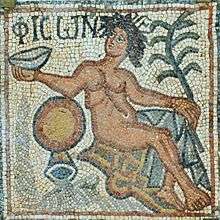Pishon
| Part of a series on the |
| Bible |
|---|
 |
|
Interpretation |
|
Perspectives |
|
|

The Pishon (Hebrew: פִּישׁוֹן Pîšōn) is one of four rivers (along with Hiddekel (Tigris), Phrath (Euphrates) and Gihon) mentioned in the Biblical Book of Genesis. In that passage, these rivers are described as arising within the Garden of Eden. The Pishon is described as encircling "the entire land of Havilah."[1]
Identification
Unlike the Tigris and the Euphrates, the Pishon has never been clearly located. It is briefly mentioned together with the Tigris in the Wisdom of Sirach (24:25), but this reference throws no more light on the location of the river. The Jewish-Roman historian Flavius Josephus, in the beginning of his Antiquities of the Jews (1st century AD) identified the Pishon with the Ganges.[2] The medieval French rabbi Rashi identified it with the Nile.
Some early modern scholars such as A.D. Calumet (1672–1757) and later figues such as Rosenmüller (1768–1835), and Kell (1807–1888), believed the source river [for Eden] was a region of springs: "The Pishon and Gihon were mountain streams. The former may have been the Phasis or Araxes, and the latter the Oxus."[3] James A. Sauer, former curator of the Harvard Semitic Museum, made an argument from geology and history that Pishon referred to what is now the Wadi Bisha, a dry channel which begins in the Hijaz Mountains near Medina to run northeast to Kuwait.[4] With the aid of satellite photos, Farouk El-Baz of Boston University traced the dry channel from Kuwait up the Wadi Al-Batin and the Wadi Al-Rummah system originating near Medina.[5]
David Rohl identified Pishon with the Uizhun, placing Havilah to the northeast of Mesopotamia. The Uizhun is known locally as the Golden River. Rising near Mt. Sahand, it meanders between ancient gold mines and lodes of lapis lazuli before feeding the Caspian Sea. Such natural resources correspond to the ones associated with the land of Havilah in Genesis.
References
- ↑ Genesis 2:11
- ↑ Josephus, Flavius. "Antiquities of the Jews - Book I". Chapter 1.3.
And Phison, which denotes a multitude, running into India, makes its exit into the sea, and is by the Greeks called Ganges. Euphrates also, as well as Tigris, goes down into the Red Sea.
- ↑ Duncan, George S. (October 1929) "The Birthplace of Man" The Scientific Monthly 29(4): pp. 359-362, p. 360.
- ↑ James A. Sauer, "The River Runs Dry," Biblical Archaeology Review, Vol. 22, No. 4, July/August 1996, pp. 52-54, 57, 64
- ↑ Farouk El-Baz, "A river in the desert", Discover, July 1993.